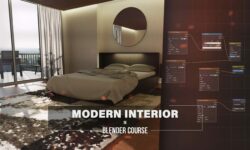3ds Max + VRay Materials Masterclass
Release date:2015, September
Duration:02 h 50 m
Author:Adam Zollinger
Skill level:Beginner
Language:English
Exercise files:Yes
Who is the target audience?
Create photoreal 3d materials using a professional workflow
Take the principles from this course and begin applying them in 3d to improve texturing skills
Better understand settings of various different types of materials, in various render engines
Apply texturing principles in standard 3ds Max materials, mental ray, corona, V-Ray for SketchUp, and V-Ray
Requirements
You will need to know your way around in 3ds Max (or similar).
You will need to have basic Photoshop skills — If not check out my beginner course for Photoshop
You will need access to 3ds Max and a V-Ray demo in order to follow along directly
Have a basic knowledge of V-Ray or other render engines will be helpful, but not essential
If haven’t used 3ds Max, or if you need to sharpen your skills before focusing specifically on textures, check out my 3ds Max PRO in 6 hrs course first.
Description
**Taught by a practicing professional
**The teacher is always available to help
**More real world examples / demonstrations to follow
**Get early access now before pricing goes up
**Join this course and get HUGE discounts on other courses from this instructor
Improve Your 3d Materials Workflow — Achieve Photorealism
This course will dive into the details of 3d materials, showing you all the important tips and tricks necessary to achieve photorealism. The course will be demonstrated within 3ds Max, and the textures will primarily be created using V-Ray materials. Other types of shaders will also be demonstrated, but the class generally teaches you principles that can be applied across several different platforms. You will learn settings, shader types, map creation, etc., all while seeing real time demonstrations of materials being created and rendered.
In short, take this course if you want to vastly improve your ability to create photoreal textures, and streamline your workflow.
Here are some of the benefits of this course:
You will learn the professional way to do things, making you fast and efficient
The quality of your materials will immediately begin to improve as you apply my professional tips and tricks
Your renderings will take on a much more photo-realistic look, as materials are one of the most important elements for realism
You gain a deep knowledge and familiarity with V-Ray (and equivalent render engines) and its settings.
After taking this course, you will understand many principles that you can then experiment with to make your images more professional
The instructor is great at supporting the students by answering all questions and offering valuable feedback
By joining this course you will also get discounted access to all the other courses offered by this instructor (see coupons in bonus section)
And so much more…
Who is the target audience?
You should take this course if you want to make better materials, regardless of the program you use
Do not take this course if you are completely new to 3d, I have another course for that
Take this course if you want to gain a more intimate knowledge of V-Ray shaders and their settings
This class is great if you know the basics of 3d, but you are looking to take your images to the next level with advanced textures





 Channel
Channel





